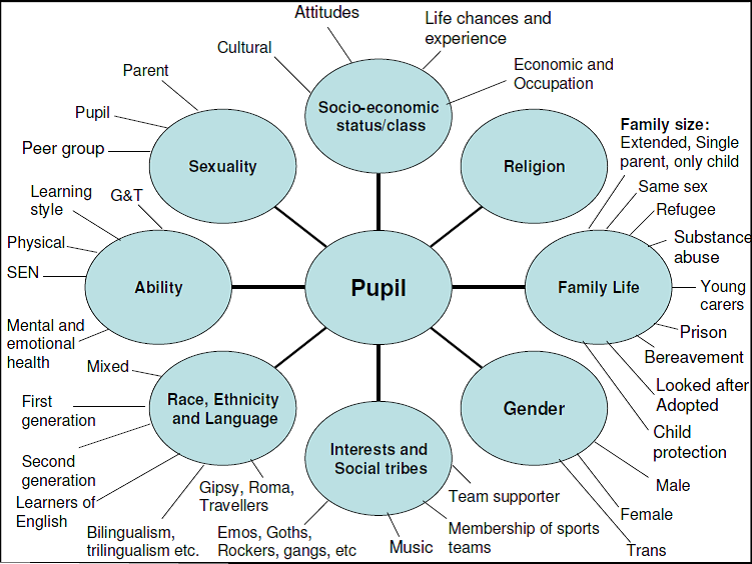“A colleague once told me that it was too late for students to put on an identity-based play because Black History Month was October and it was now November.”
Many teachers who read my recent article “What’s Your Story- Teaching for Diversity” in School Leadership Today found this painful-but-true anecdote all too familiar. The article was based on a project I led at Canterbury Christ Church University last year. It aimed to help school based mentors better address diversity. This area is frequently picked out as a weakness in training by new teachers (Davis and Crozier, 2005; TDA, 2009).
Sadly, some people don’t subscribe to this excellent magazine (shameless plug) so I thought I’d provide a brief summary here.
The article lays out four steps schools should take to improve their responses to diversity:
1. Teachers and School Leadership Teams should agree on a shared understanding of what diversity means in their school context
Traditionally, there has been a “strand based” view of diversity. For example, the organisation Multiverse lists 6 strands:
– Race and Ethnicity
– Social Class
– Religious Diversity
– Bilingual and Multilingual Learners
– Refugees and Asylum Seekers
– Travellers and Roma
I argue that this is overly narrow and does not respond to the way children and young people view themselves. A whole range of factors could be far more important in determining who pupils think they are and what matters to them. In some cases the youth sub-culture a pupil belongs to might be far more important to them than the colour of their skin.

I therefore argue that our understanding of diversity should be based on variety in pupil biographies.
Schools will differ in what they will want to take into account but should be guided by the impact that effective teaching for diversity can have:
2. Clearly identify and share why teaching for diversity matters and what benefits it can bring.
I identify three types of benefits:
– Engagement and therefore achievement
– Personal Development
– Social Development and Community Cohesion
Engagement benefits for two reasons: A familiar but intangible feature of good teaching is that teachers have “strong rapport” with pupils. I believe that this frequently comes from the ‘click’ between teachers and pupils that results from knowing where each other are coming from. Secondly, pupils are more engaged if they feel that what they are learning is relevant to them. It is easier to make something relevant to someone when you know who they really are.
Personal development is about acknowledging that pupils are continually constructing their sense of identity. Showing that an identity is accepted can make the process far less painful. For example, if a pupil is grappling with their emerging sexuality (or trying to understand their parents’) an MFL teacher who teaches all the boys how to say “ma copine” and all the girls to say “mon copin” is singularly failing to acknowledge variety in pupils’ biographies. A willingness to proactively recognise that in a diverse class, some girls might have “une copine” can be welcome relief. (I need not emphasise that this would need to be done sensitively and confidently- I’ve written about guidelines for discussing sexuality with pupils elsewhere).
Social development and community cohesion involves engaging with diversity that “is not there” as well as diversity that is there and so brings us to my third point:
3. Map out the diversity that is and is not present and audit how both are addressed
One NQT responded to a survey on diversity by saying “I work in a grammar school, not much diversity here!” Whilst our first point about widened definitions suggests that this is unlikely, it is evident that not all forms of diversity will be present in each school. Here, OFSTED’s guidance to inspectors (OFSTED 2009) is helpful.
“Where the pupil population is less diverse or predominantly of one socioeconomic, ethnic, faith or non-faith background, more will need to be done to provide opportunities for interaction between children and young people from different backgrounds” (my emphasis)
Given that pupils will live in a diverse society, may well travel for future education and will work in an increasingly globalised world, the fact that they are currently in a relatively un-diverse school does not make learning to live in a diverse society any less important. Indeed, if they do not learn to do so, their life chances might be severely limited; plenty of bright but working class pupils who visit Oxford University and find students in sub-fusc with alien norms and behaviours feel uncomfortable applying. Explicit discussion of variation between socio-economic class groups in Citizenship or Sociology lessons could go a long way to reducing the discomfort that accompanies this unfamiliarity.
I recommend an audit of different “diversity factors” which considers whether they are or are not present and how they are being addressed.
4. Continuous professional development programmes should equip staff to teach for diversity
The issues involved in this area are complex and contentious. Teachers will not all share the same understanding of diversity. They may be unsure how to acknowledge difficult pupil biographies without treating them as excuses for poor behaviour or effort. Striking a balance between rapport and over friendliness is not always easy. Feeling confident responding to challenges from pupils on areas like sexuality can be difficult. I therefore encourage schools to plan INSET that equips staff to deal with all of these issues confidently and sensitively.
The full article provides case studies of how different schools have responded to diversity and some more detailed recommendations. I have also produced a booklet for Canterbury Christ Church University that has been distributed to schools involved in their GRTP program. It is an area I’m keen to work on with more schools so do get in touch if you’re interested.
References
Davis and Crozier, (2005), Diversity and Teacher Education, University of Sunderland
OFSTED, (2009), Inspecting Maintained Schools’ Duty to Promote Community Cohesion
TDA, (2009), http://www.tda.gov.uk/upload/resources/pdf/r/results_nqt_survey09.pdf
Comments